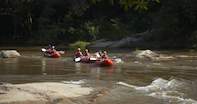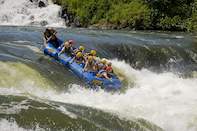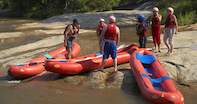History of Rafting

Nearly 150 years ago, in 1858, John Hanning Speke became the first European explorer to set eyes on Lake Victoria. This magnificent rift valley lake is popularly believed to be the source of the White Nile, but in actual fact the ultimate source is the Ruvyironza River, a mountainous stream flowing into the lake from Burundi.
Since the days of these early explorers, the 5,584 km Nile River has gripped the imagination of thousands of latter-day adventurers. Nile River Explorers were the first commercial rafting operation to scout (and operate on) the Nile, and since 1995 their guides have led numerous whitewater trips on this mighty river.
Modern-day rafting itself dates back to 1842 and the exploration of the Platte River in the USA by a Lieutenant John Fremont. They used rafts constructed from four independent rubber-and-cloth tubes, with a wrap-around floor. Inflatable vessels were first developed as life rafts and military craft, but became so popular with recreational adventurers that the sport has been included in the Olympic Games since 1992.
Potential Hazards

Here are some of the hazards to watch out for: whirlpools are generally found where the water course suddenly widens; siphons form where the current flows through boulders or potholes to cause a suction effect; standing waves are waves which breaking up-river, usually just beyond a massive, submerged rock or hole; strainers appear where the river forces its way through dead trees, fences or debris and lateral waves generally come off obstructions or river features at an angle to the water flow.
There are also hydraulics or ‘holes’ (a reversal of flow where variable water speeds force some water back upstream); keepers or ‘washing machines’ (a hole through which water constantly recycles and thus hold you under indefinitely) and eddies (an area of relative calm protected by an up-river obstacle). Fortunately, most commercial rafting trips are run along relatively safe stretches of river, and you can therefore relax and enjoy the rush!
A key water skill any recreational rafter should master is how to read a river. Even though your guide will take responsibility when you join a commercial trip, some water sense will stand you in good stead should things go wrong.
If you are paddling an unknown river and suspect any danger ahead, make every effort to scout the section ahead. Should you still be in any doubt as to your safety, opt to portage your boat until you reach a safe stretch of the river again. Constantly look out and listen for any changes in water characteristics as you move down the river too.
What to Pack

Equipment: A rafting trip is often a once in a lifetime experience, and you therefore need not worry too much about equipment. Always make sure you pack a water-resistant sunscreen, a hat or cap with a chin strap, a windproof jacket and river shoes. If you’re taking sunglasses and a camera, make sure they are well secured and waterproof.
Established operators will furnish you with a river helmet (make sure it fits well and that you have secured the chin-strap) and a personal flotation device or PFD. Additional protection, such as knee pads, may be supplied in shallow rivers, while cold-water courses and winter trips may necessitate neoprene wetsuits for paddling jackets.
Every raft should be equipped with a throw-line, and your guide should demonstrate the use of this item before you set off. This is a safety line coiled inside a bag, and is there for use during a rescue situation when the safety paddlers cannot reach a ‘swimmer’ (someone who has fallen off the raft).